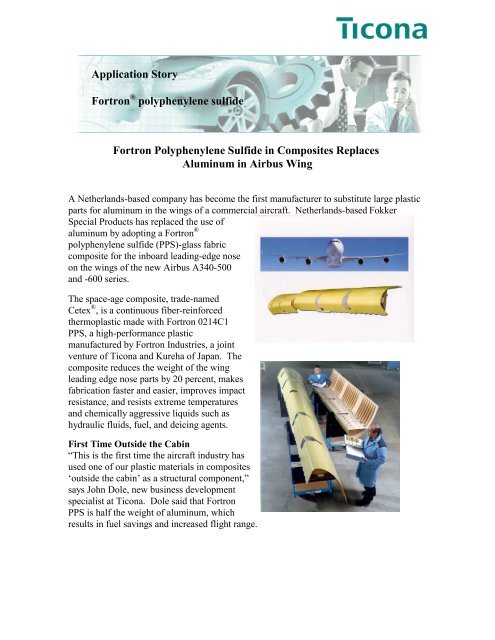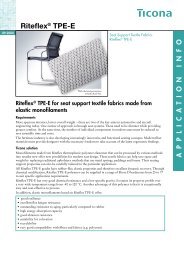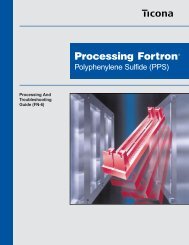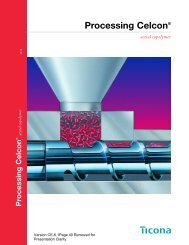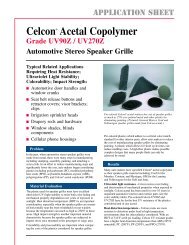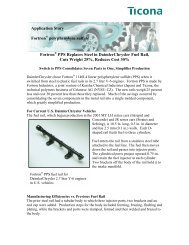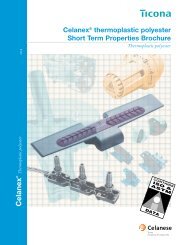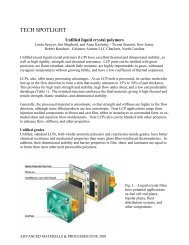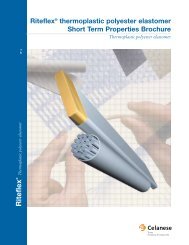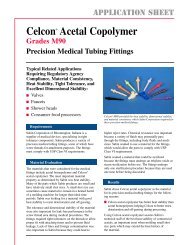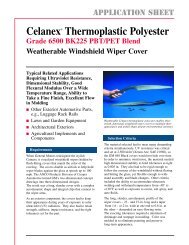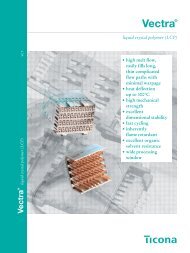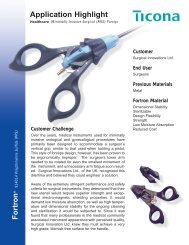Fortron PPS Airbus Wing - Hi Polymers
Fortron PPS Airbus Wing - Hi Polymers
Fortron PPS Airbus Wing - Hi Polymers
- No tags were found...
Create successful ePaper yourself
Turn your PDF publications into a flip-book with our unique Google optimized e-Paper software.
Application Story<strong>Fortron</strong> ® polyphenylene sulfide<strong>Fortron</strong> Polyphenylene Sulfide in Composites ReplacesAluminum in <strong>Airbus</strong> <strong>Wing</strong>A Netherlands-based company has become the first manufacturer to substitute large plasticparts for aluminum in the wings of a commercial aircraft. Netherlands-based FokkerSpecial Products has replaced the use ofaluminum by adopting a <strong>Fortron</strong> ®polyphenylene sulfide (<strong>PPS</strong>)-glass fabriccomposite for the inboard leading-edge noseon the wings of the new <strong>Airbus</strong> A340-500and -600 series.The space-age composite, trade-namedCetex ® , is a continuous fiber-reinforcedthermoplastic made with <strong>Fortron</strong> 0214C1<strong>PPS</strong>, a high-performance plasticmanufactured by <strong>Fortron</strong> Industries, a jointventure of Ticona and Kureha of Japan. Thecomposite reduces the weight of the wingleading edge nose parts by 20 percent, makesfabrication faster and easier, improves impactresistance, and resists extreme temperaturesand chemically aggressive liquids such ashydraulic fluids, fuel, and deicing agents.First Time Outside the Cabin“This is the first time the aircraft industry hasused one of our plastic materials in composites‘outside the cabin’ as a structural component,”says John Dole, new business developmentspecialist at Ticona. Dole said that <strong>Fortron</strong><strong>PPS</strong> is half the weight of aluminum, whichresults in fuel savings and increased flight range.
"<strong>Fortron</strong> <strong>PPS</strong> is tougher, stronger and more ductile than other similar materials," he said,"and it maintains its properties over a very broad range of temperatures, up to 240 o C andwell below -40 o C – essential qualities because of the extended cruising range and altitudesof these giant aircraft.”“<strong>Fortron</strong> <strong>PPS</strong> gives us the advanced processing and performance characteristics needed tocreate a revolutionary leading-edge nose,” says Arnt Offringa, engineering and R&Dmanager for Fokker Special Products. “It also allows the parts to be welded. This is asignificant factor, as we are able to create strong, homogeneous parts and sections withoutthe added effort and expense of riveting.”Beyond the <strong>Wing</strong>sAccording to Willem Van Dreumel, research director at Ten Cate, Nijverdal, theNetherlands-based supplier of the Cetex composite, <strong>Fortron</strong>’s benefits extend well beyondthe wings of the new <strong>Airbus</strong> models. “Cetex composites made with <strong>Fortron</strong> <strong>PPS</strong> also formthe flaps or ailerons, and the keel beam, which are made by the French fabricatorAerospatiale," Mr. van Dreumel said. "It's the only <strong>PPS</strong> qualified for the new <strong>Airbus</strong> airlinersbecause it offers optimum viscosity, chemical, mechanical and thermal properties.”Technical Information: 1-800-833-4882 Customer Services: 1-800-526-4960NOTICE TO USERS: To the best of our knowledge, the information contained in this publication is accurate; however, we do not assumeany liability whatsoever for the accuracy and completeness of such information. The information contained in this publication should not be construed as apromise or guarantee of specific properties of our products.Any values shown are based on testing of laboratory test specimens and represent data that fall within the standard range of properties for natural material.These values alone do not represent a sufficient basis for any part design. Colorants or other additives may cause significant variations in data values.Properties of molded parts can be influenced by a wide variety of factors including, but not limited to, material selection, additives, part design, processingconditions and environmental exposure. Any determination of the suitability of a particular material and part design for any use contemplated by the users andthe manner of such use is the sole responsibility of the users, who must assure themselves that the material as subsequently processed meets the needs of theirparticular product or use.It is the sole responsibility of the users to investigate whether any existing patents are infringed by the use of the materials mentioned in this publication.Please call the numbers listed for additional technical information. Call Customer Services for the appropriate Materials Safety Data Sheets (MSDS) beforeattempting to process our products.The products mentioned herein are not intended for use in medical or dental implants.Ticona90 Morris AvenueSummit, NJ 07901www.ticona.com01-332/Elec/0601


